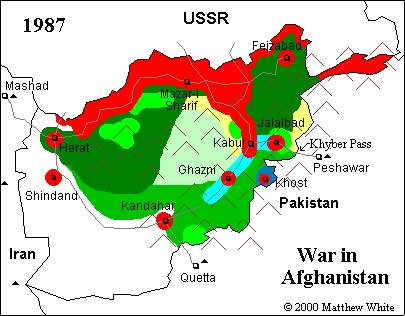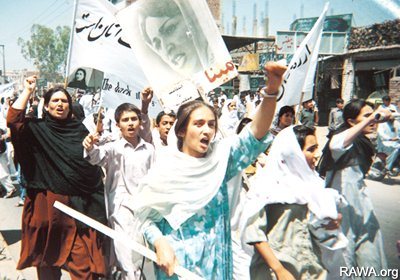Afghanistan Bleeds for You, Part One
This is all Jimmy Carter’s fault. Despite his reputation as a champion of democracy and the poor, former President Carter is directly responsible for the blood and carnage in the mountains of Afghanistan and the fields of Pennsylvania.
Back during the Cold War, the Carter administration was stinging from a rebuke at the hands of the Organization of American States. The OAS had roundly rejected Carter’s request to create a military coalition to invade Nicaragua and oust the victorious revolutionary government of the Sandinistas. Formally known as the FSLN, they had successfully overthrown the corrupt, vile Somosa dictatorship.
The Carter administration didn’t view the Sandinista rebellion as a legitimate response of an oppressed nation to rid itself of a government run by thieves and murderers, but as a territorial loss to the Communist Menace. A loss in America’s own backyard, no less. Something had to be done, and the wise asses in Washington came up with a brilliant plan.
There sat Afghanistan: a simple, slightly backward country RIGHT ON THE SOVIET UNION’S BORDER!

With little national infrastructure, the country was more an alliance of tribal and ethnic groups than a country. It would be child’s play for a superpower like the U.S. to destabilize the pro-Soviet government in Kabul by playing off different ethnic groups against the secular government, which had little influence beyond the capital’s vicinity.
Carter began to funnel arms and money into Afghanistan, via Pakistan, and to develop groups of Islamic jihadists to attack the Communist Menace’s puppet regime there. Radical clergymen and opium producers were converted into ruthless, well-armed warlords and set against the Afghan regime, which crumbled almost instantly.
When the mighty Red Army invaded Afghanistan to “restore order,” the Soviets had stepped into Carter’s trap. Carter could now claim to support “freedom fighters” in their bid to oust the Communist Menace from their country.
Years later, when the Soviet army retreated from its own Vietnamesque defeat, the last general to remove his troops from Afghanistan summarized his experience as “Dust, lice, and blood.”
Rather than usher in a new era of peace and democracy, however, the loss of centralized governmental authority escalated the violence. Rival factions of jihadis and opium warlords battled for supremacy. After the collapse of the Red Menace, the U.S. washed its hands of Afghanistan, and declined to help solve the turmoil it had created.
Years of conflict followed and Afghanistan’s major cities were reduces to mounds of ruins. Yet the wise asses in Washington, under the Reagan, Bush and Clinton administrations, had come up with yet another plan for Afghanistan.
In order to tap into vast oil and natural gas reserves in land-locked central Asia, oil producers instructed the U.S. government to put an end to the factionalism that prevented Afghanistan from coalescing into a nation. In order to get to the oil and gas, they needed a pipeline across the divided, warring country.
Suddenly, the U.S. threw its money and weaponry at a new militant group it created in Pakistan with the aid of a Bush family acquaintance, Osama bin Laden. These Taliban (which means “religious students”) were recruited from all the Islamic world and were the most devoted and military-minded of the jihadis (“holy warriors”). With the country nearly bled dry, the Taliban swept across Afghanistan, promising to bring stability and peace to the country after nearly two decades of civil war. Many people took them at their word and welcomed the Taliban.
The Taliban never fulfilled their promises.
They ruled through arbitrary use of force and wretched living conditions, which their strict edicts exacerbated. The Taliban enforced a version of so-called Islamic law more repressive than any found throughout the history of Islam.
When the Taliban seized control of most of Afghanistan, the world recoiled in horror at their repression of women, their intolerance of other religions, and the utter brutality of their rule. Only three countries recognized the Taliban government as being legitimate: the United Arab Emirates, Saudi Arabia, and the U.S.
By the time the U.S. government realized the results of its decades-long bungling in Afghan affairs, it was too late to do anything about it. As our appointed leader (Bush the lesser) flew to Florida to assist his little brother – and coup co-conspirator – with some election year photo ops, sitting unsigned on his desk in the Oval Office were orders authorizing a military campaign against the Taliban, and their al-Qaeda allies. The same day, the violence brewed up by James Earl Carter and left simmering since the 70s was brought to the U.S. by the jihadis the CIA had trained and armed.
Osama bin Laden gave Bush II an excuse to put the U.S. under the thumb of the Office of Homeland Security, and the American experiment in representative government came crashing to an end.
Afghanistan Bleeds For You – Part Two
Impoverished, far-away Afghanistan was used as a pawn by the U.S. during the Cold War. Once the Soviet Union had suffered a military defeat by the CIA-backed mujahideen, Washington lost interest in the war-ravaged country. Civil war raged across Afghanistan, starting in the mid 70s, and continuing to this day. The violence now spills over its borders, into neighboring Pakistan and Uzbekistan, and has even touched the shores of the U.S.
Yet all this time, a different outcome was possible, if only the world had shown interest.
In 1978, a college student, a young Afghan woman named Meena Keshwar Kamal, recognized the threat that the CIA-sponsored jihadis represented to the rights, security, health and safety of women. Meena began to organize women and founded the Revolutionary Association of the Women of Afghanistan at a time when speaking out against the Soviet-backed government was dealt with through violent repression.
RAWA initially organized women and girl students to demand that women’s human rights be protected. “We are not here to fight, but to articulate the will of the people and to appeal to the country’s conscience,” they proclaimed.
RAWA demonstrated against the feuding communist factions who were battling one another for control of the government. RAWA simply wanted democratic rule in their country, as opposed to the strict authoritarian regimes the communists and jihadis were trying to implement.
As the pro-Soviet regime persecuted male intellectuals and activist dissidents, Meena and RAWA stepped forward. They held rallies with female students “speaking poetry” against the government. Faced with crowds of girls in school uniforms and woman college students, the terrified police forces fired upon the unarmed demonstrators. At one rally, two children were killed. Rather than be intimidated into silence, however, RAWA was outraged. By killing school girls, the communists had shown both their cowardice and ruthlessness. Afterwards, few girls across the country would listen to anything the government or their lackeys had to say.

RAWA grew nationwide as a clandestine organization, even as a succession of increasingly repressive regimes and regional warlords seized power.
read more a bout Meena,
The contrast between RAWA and the Taliban could not be more descriptive in the contrast of their core values. RAWA provides schools for girls; the Taliban forbids girls to be educated, except in household duties. The Taliban forbids women from working outside their homes; RAWA helps women, particularly those widowed and orphaned by warfare, and religious or political repression, to develop job skills in order to achieve economic viability. The Taliban forbids women to work as doctors, or for male doctors to treat women patients, except under particular circumstances which are not often feasible. RAWA encourages women to become doctors, and operates clinics to treat women and children.
After more than 25 years of non-stop education and service among Afghanistan’s more than 5 million refugees, RAWA is renowned among the Afghan people as the only group that actually keeps its word and does not try to force its way into power through arms. Instead, the same men who have plagued Afghanistan through their violence and corruption are lined up time and time again to divvy up the country.
When the Taliban was sent scurrying off to the hills like the miserable rodents they are, Afghan men rejoiced. Many celebrated by shaving off their beards, which were mandatory under the Taliban’s reign. Women, however, have yet to cast off their burquas. Until recently, one of the movers and shakers within the warlord factions was a man named Gulbuddin Hekmatyer, a man who had originally come to prominence as a fundamentalist college student. He and his fanatical followers would throw acid in the uncovered faces of women students who dressed like modern women elsewhere in the world. That was back in the 70s.
Contrast this cowardly thug with RAWA‘s founder Meena.
Forced underground by the Soviet-backed communist government in the 70s, Meena never gave up the struggle. Her compassion for, and genuine love of, her fellow Afghans still inspires all who knew her. RAWA doesn’t idolize her the way many communist and religious organizations do their founders. Meena is remembered because many RAWA activists knew and loved her, as she knew and loved them.
In 1986, Meena’s college nemesis Hekmatyr, along with Pakistani intelligence forces developed by the CIA, tortured and killed Meena’s husband, Faiz Ahmed, himself involved in political opposition to both the communists and the jihadis. The following year, they did the same with Meena.
To America’s shame, it is men like Hekmatyr who our government turns to when they wish to build a government in Afghanistan, while RAWA can only join the process by clamouring for attention. The interim president of Afghanistan, Hamid Karzai, has not rescinded the rule of Islamic law, even if he has softened it a little. That’s why Afghan women have yet to shed their burquas, despite their country’s “liberation.”
Beneath their burquas, RAWA activists will continue to smuggle food and medicine to women and children unable to attain them legally. They’ll continue to provide clothes and blankets to refugees, run illegal schools for girls and document atrocities committed against women and other dissidents by the thugs and thieves Bush II’s – and now Obama’s – administration is attempting to install as Afghanistan’s rulers.
i wrote this while in prison. it was originally published in street roots newspaper, as two instalments of my column “word from the revolution.”
…wrote a lot of good stuff for them…

The soviet army come to Afghanistan to stop the civil war they were the real heors who should not be forget.
LikeLike
if invasions by foreign armies are the solutions to people’s problems, then we are all in great trouble. the extremism of both soviet and american armed forces has left little middle ground for rebuilding lives disrupted by decades of civil war. with the exceptions of ngo’s and people’s movements like RAWA, there are only extremists of one sort or another everywhere one looks in afghanistan.
i’ll give you this point, though – at least under soviet occupation, women could work outside the home and send their daughters to school.
LikeLike